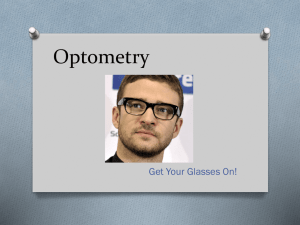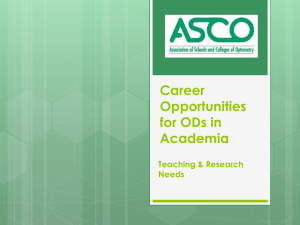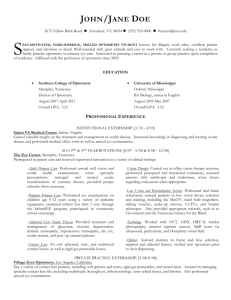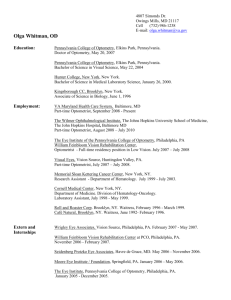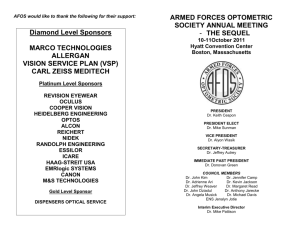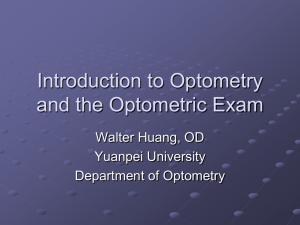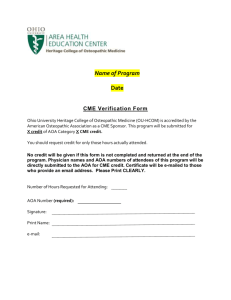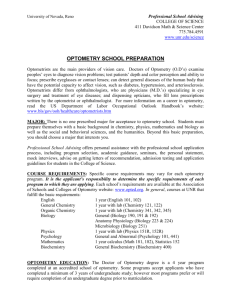weekly media monitoring highlights
advertisement
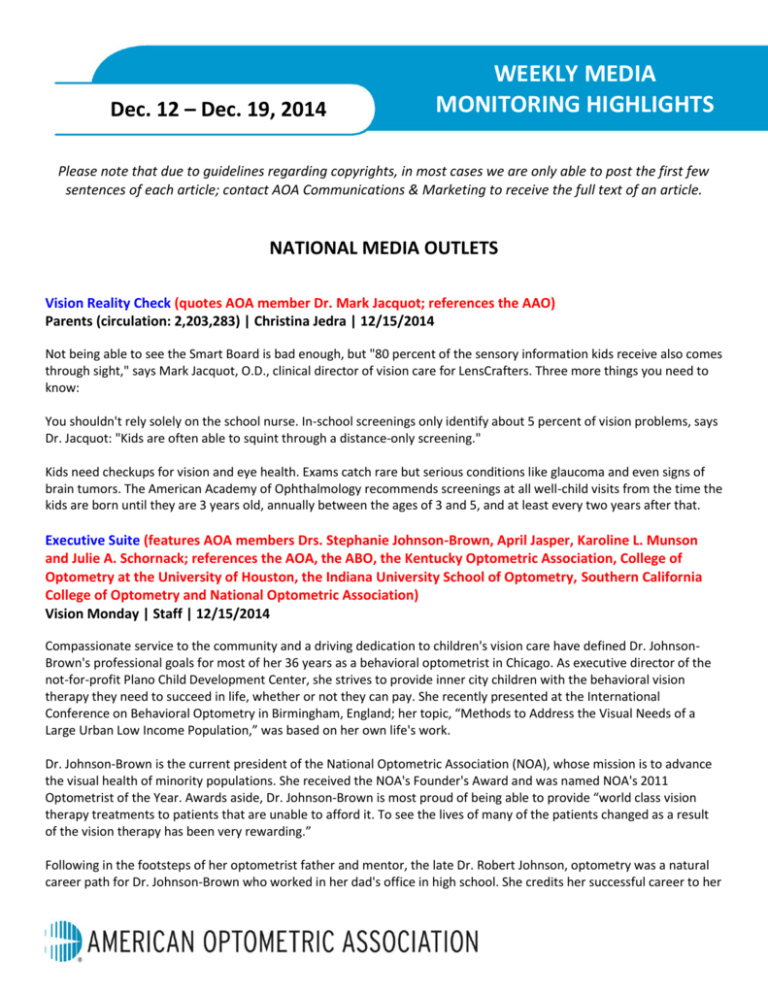
Dec. 12 – Dec. 19, 2014 WEEKLY MEDIA MONITORING HIGHLIGHTS Please note that due to guidelines regarding copyrights, in most cases we are only able to post the first few sentences of each article; contact AOA Communications & Marketing to receive the full text of an article. NATIONAL MEDIA OUTLETS Vision Reality Check (quotes AOA member Dr. Mark Jacquot; references the AAO) Parents (circulation: 2,203,283) | Christina Jedra | 12/15/2014 Not being able to see the Smart Board is bad enough, but "80 percent of the sensory information kids receive also comes through sight," says Mark Jacquot, O.D., clinical director of vision care for LensCrafters. Three more things you need to know: You shouldn't rely solely on the school nurse. In-school screenings only identify about 5 percent of vision problems, says Dr. Jacquot: "Kids are often able to squint through a distance-only screening." Kids need checkups for vision and eye health. Exams catch rare but serious conditions like glaucoma and even signs of brain tumors. The American Academy of Ophthalmology recommends screenings at all well-child visits from the time the kids are born until they are 3 years old, annually between the ages of 3 and 5, and at least every two years after that. Executive Suite (features AOA members Drs. Stephanie Johnson-Brown, April Jasper, Karoline L. Munson and Julie A. Schornack; references the AOA, the ABO, the Kentucky Optometric Association, College of Optometry at the University of Houston, the Indiana University School of Optometry, Southern California College of Optometry and National Optometric Association) Vision Monday | Staff | 12/15/2014 Compassionate service to the community and a driving dedication to children's vision care have defined Dr. JohnsonBrown's professional goals for most of her 36 years as a behavioral optometrist in Chicago. As executive director of the not-for-profit Plano Child Development Center, she strives to provide inner city children with the behavioral vision therapy they need to succeed in life, whether or not they can pay. She recently presented at the International Conference on Behavioral Optometry in Birmingham, England; her topic, “Methods to Address the Visual Needs of a Large Urban Low Income Population,” was based on her own life's work. Dr. Johnson-Brown is the current president of the National Optometric Association (NOA), whose mission is to advance the visual health of minority populations. She received the NOA's Founder's Award and was named NOA's 2011 Optometrist of the Year. Awards aside, Dr. Johnson-Brown is most proud of being able to provide “world class vision therapy treatments to patients that are unable to afford it. To see the lives of many of the patients changed as a result of the vision therapy has been very rewarding.” Following in the footsteps of her optometrist father and mentor, the late Dr. Robert Johnson, optometry was a natural career path for Dr. Johnson-Brown who worked in her dad's office in high school. She credits her successful career to her dad's example and “the passion I have for what I do and what I believe,” along with her ability to see the big picture and to be a visionary. Rising Stars (features AOA members Drs. Kirsten E. Albrecht, Amanda Nanasy, Katie Gilbert-Spear, Captain Lauren Joy Stone and Gina M. Wesley; references the AOA, the Minnesota Optometric Association, Nova Southeastern University College of Optometry, The Ohio State University College of Optometry and AOA member Dr. Carl Spear) Vision Monday | Staff | 12/15/2014 Kirsten E. Albrecht, OD DIRECTOR OF PROFESSIONAL SERVICES FOR ACQUISITIONS MyEyeDr Kannapolis, North Carolina CHOSEN BECAUSE… “Kirsten works with ODs in newly acquired practices over a large geographic area to integrate them into a new practice modality for MyEyeDr. She is an important first point of contact for many established ODs as they transition from ownership to working for a large regional practice.” Having run two eyecare practices in North Carolina, Kirsten Albrecht, OD knows a thing or two about keeping one eye on patient care and the other on the business side. “When I started in Concord in 2002, I was one of the first female optometrists practicing, so in the beginning I was met with trust issues. My patient base grew after I earned that trust, which I did by listening, being an educator and building a relationship that kept them coming back,” she said. The Right Way to Clean Glasses (references the AOA) News.EssilorUSA.com | Essilor USA | 12/12/2014 It's estimated that three out of four adults in the United States wear some sort of vision correction, with about 64 percent of them wearing eyeglasses. Unfortunately, most people don't know how to properly clean glasses, and instead rely on their shirt tail, a handy tissue or – yikes! – a paper towel. Why are shirts and paper towels such a bad idea? They carry dust and fibers that can scratch your lenses. The good news? Cleaning your glasses is as easy as washing your hands. According to the American Optometric Association, the best cleaning solution is quite simple: dishwashing soap and warm water. Follow these easy steps for clean glasses everyday: - Run your glasses under warm water Hottest Stories of 2014: Retina (references the AOA and AOA member Dr. Sherry Bass; quotes AOA members Drs. Michael Brown, Leo Semes, Jeffry Gerson and Diana Shechtman) Optometry Times | Colleen E. McCarthy | 12/12/2014 Michael Brown, OD, FAAO, shared the story of his own retinal detachment while thousands of miles away from home. “There was a series of flashes, like warning flares, and then a black tide, an oil slick of a blind spot that started down and to the left and crept toward the center of my vision, arcs of lightning heralding its advance,” Dr. Brown writes. “I knew what was happening, but I didn't want to believe it. My wife and I had snuck out to California from Alabama for some much needed R&R—and now this.” Doctor, heal thyself, says Optometry Times Chief Optometric Editor Ernie Bowling, OD, FAAO, NAP. “This is an excellent first person account of a devastating presentation through the eyes of a person who has seen it countless times from the other side of the chair,” he said. “Dr. Brown voices his experiences in a way few other ODs could.” All Children Should Have Vision Health Screening Between Age 3 and 6, Expert Panel Recommends (quotes AOA member Dr. Anthony Adams; references the American Academy of Optometry and Prevent Blindness) Newswise, press release | Wolters Kluwer Health: Lippincott Williams and Wilkins | 12/12/2014 All children should undergo vision health screening between age 36 and 72 months—preferably every year—using evidence-based test methods and with effective referral and follow-up, according to recommendations published in the January issue of Optometry and Vision Science, official journal of the American Academy of Optometry. The journal is published by Lippincott Williams & Wilkins, a part of Wolters Kluwer Health. The National Expert Panel to The National Center for Children's Vision Health makes recommendations for vision health screening in preschool-aged children, including specific guidance for screening tests and the screening process. The recommendations are available as open access articles on the journal website: http://optvissci.com/. Vision Health Screening in Preschoolers: Recommendations and Best Practices Preschool-aged children need screening for early detection of vision problems, particularly refractive error (vision problems requiring glasses), amblyopia ("lazy eye"), and strabismus (a disorder of eye alignment). Prompt diagnosis and referral to an eye care professional (optometrist or ophthalmologist) has major implications for school readiness and child development. Note Your Health Testing Schedule (Translated from Indonesian to English: references the AOA) Cosmopolitan Indonesia - Online (UVPM: N/A) | Staff | 12/13/2014 Eye Health Checks Period: 2 Year One Advice from the American Optometric Association eye health checks conducted at least once every two years. Although actually, it is advisable to check that indeed you have had problems with eyesight and had to use glasses or contact lenses. Use These Three Tips to Incorporate Wellness into Your Practice (bylined by AOA member Dr. Kimberly K. Reed; references Nova Southeastern University College of Optometry) Optometric Management | Kimberly K. Reed, O.D., F.A.A.O. | 12/12/2014 With a plethora of research linking nutrition with eye health, not to mention the benefits of a healthy lifestyle, more eyecare practitioners want to institute nutrition and wellness principles into their practices. Here are three ways this can be accomplished. 1. Send a healthy message By Diagnosing and Treating Patients Who Have Ocular Surface Disease, Your Practice Can Reap Big Rewards (bylined by AOA member Dr. Douglas K. Devries) Optometric Management | Douglas K. Devries, O.D. | 12/12/2014 With decreased reimbursement on both services and products within vision plans and the upswing in the Internet dispensing of contact lenses and glasses, not to mention the changing landscape of health care (more patients), you should consider adding ocular surface disease (OSD) to your business plan, if you haven't already. Here, I explain why and how to accomplish this. Why add OSD? You should add OSD to your business plan for three reasons: 1. Dry eye disease (DED) and ocular allergy are the most prevalent conditions in patients. Up to 40% of the U.S. population has experienced ocular allergy symptoms at least once in their lifetime, with the peak in June and July, reports a recent study in the Journal of Allergy and Clinical Immunology. Meanwhile, an estimated 25 million people in the United States have DED, reveals a recent Market Scope report. With the continuing growth of computer device usage, it will likely increase. Here's How to Blaze a Trail Others Will Want to Follow (bylined by AOA member Dr. Michael S. Rothschild) Optometric Management | Michael S. Rothschild, O.D. | 12/12/2014 From business magazines to the New York Times Bestseller List to posts on the Web, it's clear that leadership is an enormous topic that attracts a lot of interest. A Google search of “leadership quotes” generates more than 86 million results. My favorite is attributed to Margaret Thatcher: “Being a leader is like being a lady. If you have to say you are, then you probably are not.” Leadership is easy to talk about, but a difficult quality to understand. One challenge is that nearly everyone has a slightly different idea of what a leader is. If we use Google and Amazon as reference points, there are many definitions of “leadership.” After studying the topic for years, I have developed a definition of leadership that best fits my understanding: How to Create Efficiencies While Remaining EHR Compliant (bylined by AOA members Drs. Lorie Lippiatt and Kim Castleberry) Optometric Management | Lorie Lippiatt, O.D. and Kim Castleberry, O.D. | 12/12/2014 With the recent government EHR patient documentation requirements, many optometrists feel that patient care is suffering rather than improving. Some feel that they and their staffs are now spending so much time meeting data collection obligations that providing quality patient care is no longer possible. Here, we explain how you can streamline practice workflow to provide high-level patient care while also adhering to EHR patient documentation requirements. Evaluate current workflow patterns To be sure, the daily business processes in optometric practice are overwhelming. The first step in managing effective change in workflow patterns is through the “discovery” phase of current workflow processes. By following the steps below, you will gain an appreciation for the workflow patterns in your office: Last Minute Cancellations Canceled With Everseat App (quotes AOA member Dr. Richard Edlow) Vision Monday | John Sailer | 12/15/2014 Everseat, the app that fills last minute cancellations, is only a year old and already serves over 40 specialties, including optometry and ophthalmology. “When we can match up someone's need with our open time, it's an effective tool,” said Richard Edlow, OD, an early adopter who uses the technology in his one location practice, Catonsville Eye Group, and in two of Katzen Eye Group's five locations, both in the Baltimore metropolitan area. Edlow's return on investment calculations after using Everseat for only a few months lead him to be a strong proponent of the app. He estimates that each refilled last-minute cancellation generates about $280, based on a cost of about $2 per day for the monthly license, revenue of $80 for the average eye exam and $300 for the average eyewear sale (minus one-third for cost of goods sold). “ROI is tangible, real and relatively fast,” said Everseat co-founder and CEO, Jeff Peres. The app is particularly effective for practices with many appointments across multiple locations. The day dba interviewed Edlow, 23 of 621 appointments were canceled. “If we can fill just one to two of those appointments, that's significant,” Edlow told dba. He explained that the app is particularly effective for pediatric ophthalmologists: “Kids get sick all the time, and lots of moms are home with kids and can bring them in at the last minute.” Industry Veteran Troy Hall Named Chief Operating Officer of Vision Trends (quotes AOA members Drs. Michael Toups and Douglas Inns; references Prevent Blindness Texas) Vision Monday | Staff | 12/15/2014 Vision Trends, Inc., a national alliance of independent optometrists, has hired vision industry veteran, Troy Hall, as chief operating officer. He will oversee day-to-day business operations, and he will work with co-founders, Michael Toups, OD, and Douglas Inns, OD, on the mid-sized alliance's long-term growth strategy. With more than 15 years of experience in the vision care industry and more than 20 years as a strategic marketing and business development professional, Hall held executive leadership positions building the strategic marketing, customer acquisition and retention, product innovation and business development functions for EyeMed (a Luxottica Group S.p.A. company) and Davis Vision (a subsidiary of HVHC, Inc., a Higmark company). “I have been fortunate to contribute to the success of some of the world's largest vision care companies,” said Hall. “Because of this experience, I wholeheartedly believe that sustainable, long-term growth of the vision care industry requires delivering more patients to those optometrists committed to delivering quality health care and building solid business practices.” What is the Association Between Vision Loss and Quality of Life? (references the American Academy of Optometry) LifestylesOver50.com, press release | Center for Vision Loss | 12/15/2014 VisionAware (www.visionaware.org) reported recently that there is new research available indicating that patients are not referred for low vision services in a timely and efficient manner. This statement came from a major new study from the National Center for Chronic Disease Prevention and Halth Promotion, Centers for Disease Control and Prevention (CDC) and was presented at the November, 2014 American Academy of Optometry Annual Meeting. If you have vision which can no longer be corrected with medical treatment, surgery or prescription lenses, you have low vision. This is not the same as being blind, however. It does mean that doing daily tasks become more difficult. You might not be able to read, cook, shop, write out you checks, watch television or thread a needle without assistance. Certainly individuals newly-diagnosed with low vision may respond with anger or depression because a diagnosis of low vision also means a loss of independence. In addition, visual impairment and health-related issues often go hand-inhand for adults 65 or older. The Center for Vision Loss, the region's only community benefit organization dedicated to improving the lives of people with vision loss, wants you to know that we can help. We provide programs and services including social services, lifeskills education, support groups, socialization activities, escorted transportation with a sighted guide and low vision services. Dr. Anthony Silvetti, OD, Low Vision Specialist, directs our Low Vision Clinics in both our Lehigh Valley and Monroe County Offices. Dr. Silvetti can provide a special low vision examination and also introduce you to aids and assistive technology which can enhance your remaining vision and allow you to perform tasks to improve your level of independence. Alcon Supports New ISO Standard for Contact Lens Disinfection Testing (references the AOA, the American Academy of Optometry and the AAO) Primary Care Optometry News | Staff | 12/15/2014 Alcon announced its support for the new standards advising that lens care products be evaluated in accordance with real-world conditions for disinfection, known an ISO standard 18259. The previous standards for lens care products evaluated the intrinsic antimicrobial efficacy of a solution without a contact lens and without assessing how the product will fare in a contact lens case, according to a press release. Recently, the U.S. Food and Drug Administration, the International Organization for Standardization and several ophthalmology and optometry associations have been studying the efficacy of testing contact lens solutions in realworld conditions. Technology Survey: What You Have Your Eyes On (quotes AOA members Drs. Craig Match, Lee D. Caplan, Judy Nguyen, Frank Chinisci, Alan Bishop, Christopher Olson and Rodney Fong) Review of Optometry | John Murphy | 12/15/2014 What technology tops optometrists' wish lists right now? You might be surprised to learn that it's not a digital fundus camera or an optical coherence tomographer (OCT). It's not even a whiz-bang instrument like a tear film osmolarity tester. The number one item that ODs are looking to buy: an automated phoropter. “The automated refraction system I bought last year increased my efficiency, reduced chair time and is a huge ‘WOW' with my patients,” says Mitchell Shulkin, OD, of San Diego. “I see more patients in less time.” Think About Your Eyes Thrives with Industry Support (features Think About Your Eyes; references the AOA, The Vision Council, Essilor and Transitions; quotes AOA president Dr. David Cockrell and AOA member Dr. Howard Purcell) Optometry Times | Colleen E. McCarthy | 12/16/2014 A year and a half after the Think About Your Eyes campaign launched to bring attention to the need for regular eye exams, the campaign is seeing results thanks to support from industry partners. This year, the campaign saw more than 940 million consumer impressions, including 400,000 national radio spots, 3,800 national cable TV spots, and more than 460,000 visitors to its website. And all that consumer attention has helped to increase patient visits for eyecare professionals. “The tens of millions of dollars' worth of Think About Your Eyes ads have been increasing eye health awareness nationally and convincing more and more Americans to get eye exams from their AOA doctor of optometry,” says David Cockrell, OD, president of the American Optometric Association (AOA). SECO International Launches SECO University Online Educational Resource Center (quotes AOA member Dr. James Herman) Vision Monday | Staff | 12/17/2014 SECO International has launched SECO University, an online educational resource center for optometric continuing education. Now available online are more than 50 hours of COPE-approved online CE, eight years and more than 1,000 hours of SECO audio course recordings, and three years of multimedia posters from SECO's advanced learning center. SECO University courses are delivered in two formats: 1) SECO special session videos with full-course lectures in high definition, and 2) the more traditional OD online course format with audio, a presentation and handout. While all online courses are exclusively for optometrists this year, SECO plans to add online courses for associated optometric professionals next year. Additional courses will be added regularly, and the courses from SECO 2015 will be available beginning May 1, 2015. Optometrists who register for the SECO 2015 all-inclusive package can access SECO University for free, otherwise the cost is $299 per year. Julie A. Schornack, O.D., M.Ed., F.A.A.O., Recognized in Vision Monday's 2014 Most Influential Women in Optical (features AOA member Dr. Julie A. Schornack; references the Illinois College of Optometry, Pacific College of Optometry and Southern California College of Optometry; quotes AOA member Dr. Kevin Alexander) eMoneyDaily.com, press release | Marshall B. Ketchum University | 12/16/2014 Chosen from a large pool of nominees named by Vision Monday readers, Marshall B. Ketchum University's own Julie A. Schornack, O.D., M.Ed., F.A.A.O. makes this year's list of influential women in optical. Dr. Schornack received her optometry degree from the Illinois College of Optometry in 1984. She then completed a Masters of Education at Pacific University College of Optometry. Dr. Schornack has been at MBKU's Southern California College of Optometry since 1986. Today, Dr. Schornack serves as the Vice President for Clinical Affairs and oversees the progress of students in the University Eye Center. She is an Assistant Professor in the Cornea and Contact Lens Service where she has responsibilities in the lecture, laboratory and clinic. She has participated in the Collaborative Longitudinal Evaluation of Keratoconus (CLEK) Study as a co-investigator. Dr. Schornack has also been involved in contact lens research and has lectured extensively on contact lens related topics. "On behalf of the entire university, I'd like to congratulate Dr. Schornack for this prestigious honor," said Marshall B. Ketchum University President Kevin Alexander, O.D., Ph.D. "For nearly 30 years, Julie has dedicated herself to the Southern California College of Optometry. She has mentored countless optometric students ensuring that the doctors who graduate from our university are prepared for today's competitive environment and shifting health care environment." Blog: A Bump on the Road to Health Care Reform (references the AOA; bylined by AOA member Dr. Scott A. Edmonds) Primary Care Optometry News | Scott A. Edmonds, O.D., F.A.A.O. | 12/18/2014 As part of my traditional December activity, I review the work of 2014 and try to make plans for the New Year. Looking forward, I see a number of clouds over the road to health care reform. A road that seemed like a clear path to the future last summer now may be facing some bumps and detours. Although technology is sure to be a big part of our future, the movement through the stages of meaningful use of our electronic health records (EHRs) and onto a fully integrated, comprehensive health delivery system may take a little longer than what was highlighted in the play book. The first cloud in the sky is a sudden lack of confidence in web-based security in general. The year 2014 has seen several large companies become the victims of either Internet hackers or at least poor electronic information policies. These issues have exposed the private information of many American citizens. These companies include Target, Home Depot and, even within our own industry, Davis Vision. The most recent hacker attack to Sony has experts baffled by the sophistication of the attack and has led these experts to ponder publicly if anything is really secure on the Internet. AOA Solicits Nominations for National Optometry Hall of Fame (features the AOA and the National Optometry Hall of Fame; references Optometry Cares) Primary Care Optometry News | Staff | 12/18/2014 The American Optometric Association is now accepting submissions for the 2015 National Optometry Hall of Fame. Optometry Cares, which administers the National Optometry Hall of Fame, will induct two optometrists this year. In a press release, the AOA announced that two categories have been formed – one category for optometrists in the academic field and one for optometrists in private practice or federal service. According to the release, nominations are considered for 4 consecutive years. Optometrists who were nominated for the 2014 AOA Distinguished Service Award will also be considered for the 2015 National Optometry Hall of Fame. University of Pikeville Announces the Creation of the Kentucky College of Optometry (references the AOA; features the University of Pikeville-Kentucky College of Optometry) Vision Monday | Staff | 12/19/2014 On Wednesday, Feb. 26, the University of Pikeville announced the creation of the Kentucky College of Optometry. The American Optometric Association's Accreditation Council on Optometric Education notified university officials the week prior that it had voted to designate the University of Pikeville-Kentucky College of Optometry as a “Stage One Applicant.” The university expects to welcome its first class in the fall of 2016, with 60 students admitted per class, for a total of 240. While the University of Pikeville already has many of the facilities necessary to accommodate the Kentucky College of Optometry, plans to build a new educational facility are under way, according to a statement from the university. A national search for a dean has begun. “Today's announcement is a product of this bold vision,” said university president, Dr. James Hurley, referring to the university's Vision 2020 strategic plan. “It was developed by faculty and staff, our trustees, alumni, community stakeholders, and most importantly, our students. Our board of trustees is fully committed to creating this opportunity for a new community of learners. UPIKE will provide the financial and human resources necessary to have one of the finest colleges of optometry in the nation.” Registration Now Open for American Board of Optometry Board Certification Exam (features the ABO; references AOA members Drs. Paul Karpecki, Lillian Kalaczinski, Stephen Montaquila, Essence Robinson and Eugene Shifrin) Vision Monday | Staff | 12/19/2014 Registration is now open for the next American Board of Optometry board certification exam period for the month of January 2015, one of two months during the year when the exam is offered. (The exam is also offered in July.) Interested optometrists can take the exam at any Prometric Testing Center around the U.S. as well as at international locations. There are currently 2,781 ABO Diplomates who have successfully passed the exam and 2,275 active candidates who have begun the qualification process but haven't taken the exam yet. Certified by the National Commission for Certifying Agencies and approved by the Centers for Medicare & Medicaid Services, the voluntary ABO board certification examination and program is for optometrists who graduated from a school or college of optometry accredited by the Accreditation Council on Optometric Education, who meet “residency or equivalent” requirements to qualify for the exam, and who hold an active license to practice therapeutic optometry in a U.S. state, commonwealth or territory. Candidates take a 160-question general examination then answer 40 questions in each of two areas of emphasis that they have selected. The six available areas of emphasis are Additional General Practice, Contact Lenses, Pediatrics/Binocular Vision/Vision Therapy, Ocular Disease Anterior, Ocular Disease Posterior, and Vision Rehabilitation/Low Vision/Neuro-Ophthalmic Rehabilitation. The exam's passing rate has been 93.1 percent. Kentucky College of Optometry Appoints Executive Council (quotes AOA member Dr. Andrew Buzzelli; features AOA member Dr. Donald Egan and the University of Pikeville - Kentucky College of Optometry; references the Pennsylvania College of Optometry, the University of Missouri-St. Louis College of Optometry, Western University of Health Sciences-College of Optometry and the Rosenberg School of Optometry) Vision Monday | Staff | 12/19/2014 Andrew Buzzelli, OD, MS, vice president for optometric education and founding dean of the new Kentucky College of Optometry at the University of Pikeville, has appointed the executive council as the founding members of the new administration of what is destined to be a new school of optometry in the U.S. Donald Egan, OD, has been chosen as the associate dean of academic affairs. Roya Attar, OD, has been selected as the director of student affairs and a senior clinical instructor for primary care optometry and anterior segment. Heather Keene will serve as the executive assistant to the dean and the director of support personnel. Egan comes to the college as a full professor with additional teaching responsibilities that will include contact lenses and primary care optometry. After receiving his doctor of optometry degree from the Pennsylvania College of Optometry and completing a post doctorate residency program with an emphasis in clinical optometry and contact lenses, he became a faculty member at the University of Waterloo School of Optometry and Vision Science. He then joined the faculty at the University of Missouri-St. Louis and developed the contact lens program for its newly established school of optometry. AOA AND AOA MEMBERS IN THE NEWS Computer Vision Syndrome (references the AOA) WLOX-TV (Biloxi, MS) (America Now broadcast) | Jennifer Emert | 12/14/2014 Just looking at something, you blink about 16 times a minute. When you're looking at the computer screen, it decreases to about 6 times a minute. and so, that can really exacerbate dryness. Setting up your desk and computer can help prevent or alleviate CVS. The American Optometric Association recommends positioning the screen about 20 to 28 inches away from the eyes, and 4 or 5 inches below eye level. It's a little bit easier for you to view it in general, for your posture, and it helps the lids to droop down just a little bit, and that protects you from dryness. Changing your computer settings to suit your vision, and changing high intensity lighting to lower wattage bulbs can help. So can covering up any windows that bring in a glare. give your eyes a break once in a while by blinking, and following the "20, 20, 20 rule" when working on a screen. For every 20 minutes of work look off for 20 seconds at about 20 feet. Intentional Study Breaks Promote Productivity, Combat Harmful Conditions (references the AOA; quotes AOA member Dr. Burt Dubow) The Collegian (Manhattan, KS) | Lindsey Staab | 12/15/2014 From garnering mental fatigue to vision problems, studying can be an intensive process. Intentionally taking intermittent breaks during your sessions can help you be more efficient with the time you spend, while counteracting the effects of sitting and staring at screens. No doubt you've heard about individuals developing vision problems or headaches in conjunction with looking at computer, phone and tablet screens for extended periods of time. Between our social media usage, video viewing, texting habits and all but necessary use of computers in order to work, people spend a lot of time staring at screens and the artificial light they emit. Doctors now identify an issue that derives from this incessant usage – Computer Vision Syndrome. Yes, it's a real thing and it can produce some particularly unfavorable side-effects that could potentially hamper your productivity. According to the American Optometric Association, CVS encompasses a group of eye and vision-related problems deriving from prolonged computer use. Symptoms can include eyestrain, headaches, blurred vision and dry eyes. A variety of factors contribute to these effects, namely poor lighting (in the setting you're working in, as well as improper screen brightness settings), glare from screens and uncorrected vision problems. The association also states that individuals who spend two or more consecutive hours in front of a screen are at greatest risk for developing CVS and related problems. Carrots Not at the Top of the List of Foods that Promote Better Eye Health, Experts Say (references the AOA and the Kentucky Optometric Association; quotes AOA member Dr. Leslie Cecil) KyForward.com (Lexington, KY)| Kentucky Optometric Association | 12/18/2014 Everyone knows they should eat five servings of fruits and vegetables each day, but what you may not know is what you eat can affect your eye health and vision as you age. Six nutrients ― antioxidants lutein and zeaxanthin, essential fatty acids, vitamins C and E and the mineral zinc ― have been identified as helping to protect eye sight and promote visual health. “Since the body doesn't make these nutrients naturally, it's important that they are incorporated into your daily diet and, in some cases, supplemented with vitamins,” said Dr. Leslie Cecil, an optometrist in Bardstown. Lions Celebrate Christmas, 75th Anniversary (references the Ohio State University College of Optometry) ThisWeek Community Newspapers (Lewis Center, OH) | Mark Dubovec | 12/17/2014 Last week, the folks in the red vests marked two special occasions. On Dec. 10, members of the Grove City Lions Club held their annual Christmas party at the China Bell restaurant, 1947 Stringtown Road, and at the same event, celebrated the club's 75th anniversary. The Grove City Lions is one of the city's oldest service organization. Optometrists Recommend Protective Eyewear Even On Cloudy Winter Days (references the AOA; quotes AOA member Dr. Steven Cohen) KJZZ-FM (Tempe, AZ) | Al Macias | 12/15/2014 Sunglasses aren't normally seen as a winter accessory but you might want to pack some for your next trip to the snow. People often worry about their eyes in the summer, but in reality they need to be protected year round. Before you hit the slopes this winter, don't forget your sunglasses because optometrist Steven Cohen says that skiers' eyes are especially at risk. “People who snow ski are at a great risk because of the higher altitude where the atmosphere is thinner so more UV winds up penetrating and plus we also deal with reflective UV," Cohen said. "In the short term, say someone goes snow skiing, they can wind up with what's called snow blindness or a condition called photokeratitis which like a sunburn to the front of the eyes.” OPTOMETRY CARES – THE AOA FOUNDATION PhilanthrOptic: #WhatAreYouGiving This Holiday Season? (references InfantSEE, Optometry Cares-The AOA Foundation, Think About Your Eyes, Essilor Vision Foundation and Prevent Blindness) Vision Monday | Staff | 12/15/2014 Is the hustle and bustle of this Holiday season getting you down? If you're still bruised and battered from Black Friday and Cyber Monday we've got just the right antidote. A new tradition began on Tuesday, Dec. 2, 2014 as charities, families, businesses, community centers and students worldwide united to celebrate generosity and to give. Known as #GivingTuesday, this global day was dedicated to giving back and several organizations in the optical community hopped on this charity bandwagon including Optometry Giving Sight, Prevent Blindness, ABB Optical Group and HelpMeSee. So if you've got the Holiday blues, take a look at the list below and make a donation—it will cheer you up to know you are giving back. ABB Optical Agrees to Match Optometry Cares Donations (features Optometry Cares – the AOA Foundation; references InfantSEE, Optometry's Fund for Disaster Relief, Camp Courage: A Helen Keller Experience,Vision USA and Healthy Eyes, Health People) Primary Care Optometry News | Staff | 12/17/2014 Optometry Cares – the American Optometric Association Foundation has announced that ABB Optical Group, in recognition of the company's 25th anniversary, will match all donations up to $25,000 through Dec. 31 to help expand eye health and vision care access for people nationwide. "At ABB, we believe in giving back to those in need and supporting causes that have a proven impact," Angel Alvarez, ABB Optical CEO, said in a press release from the company. "We invite everyone in the optometry industry to join us in supporting Optometry Cares – the AOA Foundation's mission of expanding eye health and vision care access to everyone in the U.S." Donations support Optometry Cares programs such as: InfantSee; Healthy Eyes, Health People; Vision USA; Camp Courage: A Helen Keller Experience; Optometry's Fund for Disaster Relief; endowment and scholarship funds; National Optometry Hall of Fame; and archives and museums, according to the release. Infant Vision Development: Helping Babies See Their Bright Futures! (references the AOA) MSU Extension | Kylie Rymanowicz | 12/19/2014 During the first year of life, your baby is experiencing rapid growth, physically, cognitively and emotionally. Being that vision is the least developed sense at birth, a lot happens during the first 12 months. Your baby will go from being nearsighted and having difficulty focusing their eyes to being able to imitate movements, recognize faces and play peeka-boo. To help you understand this important year of development, Michigan State University Extension has information about how vision changes during the first year of life and ways you can support it. Birth to Four Months Until around three months of age, infants cannot focus on objects that are more than 8-10 inches away from their faces. Around three months, their range of vision begins to increase but they haven't yet developed the ability to move their visual focus from one object to another.
